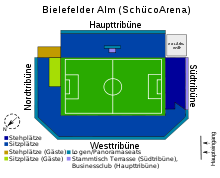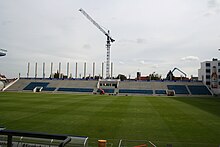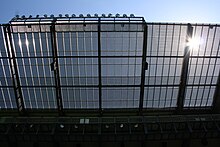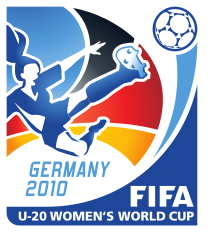SchücoArena
| SchücoArena | |
|---|---|
| Bielefelder Alm Alm Alm stadium |
|
|
|
|

|
|
| View of the main stand of the stadium | |
| Sponsor name (s) | |
|
|
| Data | |
| place | Melanchthonstrasse 31a 33615 Bielefeld , Germany |
| Coordinates | 52 ° 1 '53 " N , 8 ° 31' 1" E |
| owner | Bündnis Alm GmbH |
| operator | DSC Arminia Bielefeld GmbH & Co. KGaA |
| opening | 1926 |
| First game | May 1, 1926 Arminia Bielefeld - SC Victoria Hamburg 1: 5 |
| Renovations | 1949, 1954-1958, 1967, 1970, 1996-1999, 2004, 2006-2008 |
| surface | Hybrid lawn |
| costs | approx. 30 million euros |
| architect | Stopfel Architects (new grandstand) |
| capacity | 26,515 seats |
| playing area | 105 × 68 m |
| Societies) | |
| Events | |
The SchücoArena (traditionally: (Bielefelder) Alm or Alm-Stadion ; in the land register: Stadion an der Melanchthonstraße ) is the football stadium of the German sports club Arminia Bielefeld . The stadium on Melanchthonstrasse offers space for 26,515 spectators, making it the largest stadium in the Ostwestfalen-Lippe region . Schüco International KG has been the name sponsor of the venue since January 13, 2004 . In June 2019, the contract, which expired in 2020, was extended by five years to 2025.
Location and transport links
The stadium is characterized by its inner-city location and is located in the Mitte district in the middle of a residential area. It can be reached in about 15 minutes on foot from Bielefeld main station . The Bielefeld Stadtbahn serves the stadium via line 3 (stops “Nordpark” and “Wittekindstraße”) and 4 (stop: “Rudolf-Oetker-Halle”). Before and after Arminia Bielefeld's home games, lines 1-4 run between their actual terminus and the Lohmannshof terminus (4/10) or the turning track between the two traffic tracks shortly after exiting the tunnel into the city between the Graf-von- stops Stauffenberg-Strasse and Rudolf-Oetker-Halle . The route continues to the university , which means that there are several parking garages and parking lots for cars.
history
Naming
The question of how the unusual name for a stadium "Alm" came about in the mid- 1920s can only be speculated today. According to the most frequently cited version, the name goes back to the association member Heinrich Pehle, who said "Here it looks like on the Alm " when looking at the area . A second variant goes back to a quote from later club leader Karl Demberg ("Let them come, we will bend them on our alpine pasture!"). The handball department of the club had always claimed the authorship of the name for itself.
Humorous tongues claim that the stadium is called “Alm” because it is the highest Bundesliga venue - you need a year for promotion and a year for relegation.
Development (1926–1970)
Since the club was founded, Arminia from Bielefeld has used several sports fields in the city. In the mid-1920s, the club's handball players made contact with a farmer named Lohmann. Arminia acquired the lease on a site previously used for agriculture for 100 years . At that time, the Alm didn't have much in common with a football stadium as it is today. The playing area was like a field . The ground was uneven and there was only a lawn near the outer lines. When it rained , the water gathered in countless small furrows . Earth walls were built around the field to serve as spectator stands. There were no changing rooms. While the handball players were able to use a gazebo in the vicinity of the stadium, the footballers had to change in the Scholle (later Schütze) restaurant about 300 meters away from the pasture until well into the 1960s.
On May 1, 1926, the footballers of the DSC Arminia played their first game on the "Alm". In front of 2,000 spectators, the guests of Victoria Hamburg were able to win 5: 1. The handball department had already played on the Alm before. However, nothing is known about opponents and results. It was also the handball players who got along better with the conditions at the Alm. During the Second World War , the "Alm" was hit by a bomb. However, the damage was limited. Large parts of the fencing were dismantled and used as heating material. After the Arminia rose to the Oberliga West in 1949 , only slight changes were made to the stadium. The pitch still did not have a uniform lawn and the goal nets were made of tensioned wire mesh . In 1954 the city decided to expand the “Alm” into an “intermediate stadium” in a four-year plan.
Grass was sown over the entire playing area of the stadium . In the area of today's main grandstand, the tiers were secured by concrete steps . At that time, the stadium announcer Albrecht Lämmchen worked under adventurous conditions. He made his announcements from a ticket booth and received the information for his announcements by show of hands .
After Arminia became autumn champions of the Regionalliga West in the 1966/67 season, rumors arose that the club would have to move to the Herford Jahnstadion in the event of a promotion to the Bundesliga . The modernization of the Alm became a bone of contention between the association and the city. As a compromise, the south stand was built, on which 3,000 standing places were available. Even after this expansion, no exact capacity could be determined.
Expansion for the Bundesliga (1970–1996)
In 1970 the DSC finally rose to the Bundesliga and the “Alm” was fundamentally expanded. A covered seating grandstand was built on the west side of the stadium and a large temporary standing room made of tubular steel frames on the east side . These expansions increased the stadium's capacity to 30,000 seats. In autumn 1970 two floodlight masts with an output of 1,500 lux were erected, and on December 4, 1970 the first floodlight game took place on the "Alm". Despite adverse weather conditions, 28,000 wanted to see the game against Hertha BSC .
The players could now use the cabins in the “Almhalle” behind the south stand as changing rooms. The players reached the field through a tunnel . For safety, the tunnel entrance in the stadium was secured by fences and barbed wire . A total of 1.5 million marks were invested in the renovation work, which had to be carried out within a few weeks .
After the second ascent in 1978, the stadium's capacity was increased even further by building a large tubular steel grandstand on the north side. The first home game of the 1978/79 season against Schalke 04 saw 34,882 spectators, the largest confirmed number of spectators in the club's history. In November 1978 over 35,000 spectators are said to have seen the game against 1. FC Kaiserslautern .
After the Heysel disaster on May 29, 1985, the DFB tightened the safety requirements of the Bundesliga stadiums. In addition to the sporty descent of the Arminia, the “Alm” fell into disrepair. The tubular steel grandstands, which were only intended as a temporary measure, rusted and there was a risk of collapse on the south grandstand. After a site inspection, all the tubular steel standing stands had to be removed, which initially sank the capacity to 15,000. A new covered east stand was built, this time in a permanent construction made of precast concrete parts.
New construction of the north, west and south stands (1996–1999)
When Arminia developed promising opportunities for a direct march through to the Bundesliga during the 1995/96 season, new discussions broke out about a possible expansion or new construction of the “Alm”. At that time, the stadium was not in a condition suitable for the Bundesliga. Plans for new buildings in the “New Bahnhofsviertel”, a former inner-city industrial area, or “on the green field” together with FC Gütersloh were controversial. Finally, it was agreed to expand the “Alm” piece by piece.
After long negotiations with the residents of Melanchthonstrasse, the association reached a compromise that made the expansion possible. The association financed two thirds of the expansion projects and received guarantees from the city of Bielefeld and the state of North Rhine-Westphalia . The building work cost a total of 15 million marks. After the end of the season, the old north and west stands were demolished and replaced by new covered stands. The new grandstands were manufactured in prefabricated construction and assembled on site. The audience capacity grew to 22,512 seats.
Modern changing rooms as well as press and VIP rooms were built in the catacombs of the west stand . Forty boxes were built under the roof . In addition, the Alm received an electronic display board for the first time . After the last home game of the 1998/99 season, the lawn was completely removed so that the lawn heating prescribed by the DFB could be installed. A year later the south stand was demolished and rebuilt to match the existing new stands. A solar system was installed on the roof of the south stand . The capacity increased to 26,601 spectators, who were able to follow Arminia's home games from then on.
In the summer of 2000, the club's new office was built between the south and east stands. From a legal point of view, however, the part of the building does not belong to the stadium.
New construction of the east stand (2006-2008)
The last expansion stage - the new construction of the back straight - was initially not pursued after the decline in 2003; the realization finally started in May 2006. The initial spark for the expansion was provided by legal requirements regarding noise protection . In the course of the expansion, the opposite grandstand was demolished and a new main grandstand was built as a pure seating area. In addition, the south stand was converted into a stand-alone stand. The audience capacity increased to 27,300 seats. The originally planned increase to 28,008 places could not be realized due to building authority requirements.
There was resistance from local residents prior to construction and several lawsuits delayed the project. An amicable solution was found with the residents through a mediation process at the Minden Administrative Court .
After the unresolved conflict with the residents between the first two home games of the 2006/2007 season, only the south stand was initially converted into a full standing stand, the final expansion did not begin until the beginning of June 2007 with the demolition of the old east stand. Although the building permit had been in place since mid-April 2007, the club relied on the support of the east stand for the remaining three home games. Since the beginning of the 2007/08 season, the already completed lower tier of the new main grandstand had been put into use in sections. In March 2008, the upper tier was opened to the spectators, so that the stadium had almost reached its planned capacity. In the following weeks, the interior work (boxes, fan shop, office space) was completed.
One of the special features of the new grandstand is the glass roof construction, into which a new type of solar cell has been built. The solar cells are characterized by the fact that they did not have to be mounted on the roof, but were integrated into it. The renovation work could be observed from the south stand on weekdays. There was also a webcam on the club's website that provided pictures of the construction site around the clock.
The official inauguration of the stadium took place on June 1st, 2008 as part of a concert by Herbert Grönemeyer . Even before the actual expansion began, the reconstruction of the west stand to create new spaces for the wheelchair users who were previously on the east stand was completed. The capacity for wheelchair users increased from 30 to 41, plus the same number of places for accompanying persons.
The expansion was financed, on the one hand, by borrowing from fans ( “Bau auf Blau” campaign ) and, on the other hand, through a special stadium concept that provides a combination of a modern spectator stand and an office complex. Office space of 1460 m² (3 office units) has been rented on the second floor, and 1100 m² (6 office units) on the upper floor.
The construction of the grandstand was originally supposed to cost 11 million euros, but due to bad planning it increased to 19 million euros, which is one of the reasons for the financial crisis of the Arminia Bielefeld club from 2010.
Sales (since 2018)
On November 12, 2018, the club announced that the stadium would be sold to Bündnis Alm GmbH , of which 3BO GmbH and STBO GmbH are 50 percent shareholders . The shareholders of 3BO GmbH are four entrepreneurs active in the real estate industry. The shareholders of STBO GmbH are Dr. August Oetker KG , the Gauselmann Group , DMG Mori AG , the Böllhoff Group , JAB Josef Anstoetz KG and the Möller Group. Arminia Bielefeld has signed a 15-year lease with Bündnis Alm GmbH , with an extension clause of two times five years. In addition, the DSC has a buy-back right after five years and a permanent, exclusive right of first refusal.
In July 2019, Arminia Bielefeld became the first German professional club to set up a separate area to enable autistic people to visit the stadium without any problems. Above the north stand, a lounge and a soundproofed Snoezel room were set up in two panorama boxes , in which the games can be watched under professional supervision.
Events
Football international games
The SchücoArena has hosted international matches several times .
The German national soccer team of amateurs played a total of four times between 1974 and 1978 on what was then the "Alm". On March 31, 1974, the English amateur selection was beaten 3-1 (goals: Ewald Hammes , Charly Körbel and Heinz Traser ). A year later there was a goalless draw against Spain . The third game took place on September 21, 1977 against France and was won 2-0 (goals: Matthias Herget and Hansi Müller ). The last game of the German amateur selection, which was played in Bielefeld, was the 2-1 victory against the Chinese national team on September 26, 1978. In addition to Werner Dressel , local hero Helmut Schröder scored a goal.
A German national team only returned to the Alm 14 years later. On December 22, 1992, the male U-21 defeated Albania 4-0 in qualifying for the 1994 European Championship . The goals were scored by Heiko Herrlich (2) as well as Marco Haber and Markus Münch . A second international match for the male U-21 took place on February 17, 2004. With a goal from Bastian Schweinsteiger , Switzerland was defeated 1-0.
The German women's national team gave their business card to the Alm for the first time on March 31, 1994. The 12-0 victory in the European Championship qualifier against Wales was the highest victory of the German women's selection until 2003. Maren Meinert and Bettina Wiegmann each met three times. Silvia Neid and today's national coach Martina Voss scored two goals each . There was also one goal each from Steffi Jones and Heidi Mohr . On February 25, 2009, the German women's national team played in a friendly against China . The game in front of 17,326 spectators ended 1: 1, the German goal scored Inka Grings . Most recently, the German women's selection played on May 31, 2012 as part of the qualification for the 2013 European Championship against Romania . In the 5-0 win, Alexandra Popp met three times and Linda Bresonik and Dzsenifer Marozsán once each . On November 24, 2017, the German selection met France and won 4-0. Alexandra Popp and Svenja Huth met twice each.
In 2006, the German team met Russia in Bielefeld as part of the World Cup for people with disabilities . In the last group game, the German team won 1-0 with a goal from Andreas Timm and secured victory in group A in the preliminary round. The first international match at the SchücoArena took place on May 20, 2008; in the friendly game the teams of Turkey and Slovakia faced each other. The Turks won 1-0 with a goal from Hakan Kadir Balta .
More soccer games
On the occasion of various DFB Cup matches , the stadium served as the home ground for smaller clubs whose stadiums could not have cope with the expected crowds. In 2001, SC Paderborn 07 competed in the first round of the cup against FC Bayern Munich on the Bielefelder Alm. In 2008, VfB Fichte Bielefeld played its home game against Borussia Mönchengladbach on Melanchthonstrasse. The women's team of Arminia Bielefeld more DFB Cup games as well as local derbies in the 2. Bundesliga several times in the SchücoArena out.
U-20 Women's World Cup 2010
In 2008, the city of Bielefeld unsuccessfully applied for the SchücoArena as a venue for the 2011 Women's World Cup . The Bielefeld application made it to the final round of applications together with eleven other venues, but was eliminated from the competition on September 30th together with Magdeburg . Under the name FIFA Women's World Cup Stadium Bielefeld, the stadium was one of four venues for the 2010 Women's U-20 World Cup . Six preliminary round matches, a quarter-final, a semi-final, the game for third place and the final were played here.
The German team won the tournament with a 2-0 final victory over Nigeria . In front of 24,633 spectators, Alexandra Popp and Kim Kulig scored the goals for the German team. Immediately beforehand, the selection from South Korea secured third place in the game against Colombia with a goal from Ji So-yun .
Concerts
On June 18, 1989, Joe Cocker , BAP , Suzanne Vega and Fischer-Z played at a concert on what was then the "Alm". On August 20th, 1988 Peter Maffay gave a concert there as part of the Long Shadow Tour. On July 4, 1992, Roxette gave a concert during their Join the Joyride world tour and on September 18, 1994, Meat Loaf made a guest appearance as part of his Everything Louder tour on the "Alm". As part of the 100th anniversary of the association, a concert by British pop singer Elton John took place in the SchücoArena on July 10, 2005 . On June 1, 2008, Arminia Bielefeld celebrated the completion of the stadium with a concert by Herbert Grönemeyer in front of 25,000 spectators.
On the occasion of the 111th birthday of Arminia Bielefeld, an anniversary festival took place on June 4, 2016 with the Fantastischen Vier , Wirtz , Jamie-Lee Kriewitz , Shantallica , The BossHoss and Randale . 12,500 spectators followed the festival in the SchücoArena, where Philipp Köster and Jens Kirschnek presented the program.
See also
Web links
- arminia-bielefeld.de: Stadium on the Arminia Bielefeld website
- virtual tour
- stadiumdb.com: Schüco Arena (Bielefelder Alm)
- stadionwelt.de: Stadium guide
- groundhopping.de: Visitor report from 2005
- SchücoArena as a 3D model in SketchUp's 3D warehouse
Individual evidence
- ↑ arminia-bielefeld.de: New lawn for the SchücoArena Article from January 4, 2016
- ↑ 378 additional standing places on the south. DSC Arminia Bielefeld GmbH & Co. KGaA, September 13, 2016, accessed on September 14, 2016 .
- ↑ Naming Right: Arminia continues to play in the SchücoArena. In: stadionwelt.de. June 19, 2019, accessed June 20, 2019 .
- ↑ a b From the Alm to the Arena. Bundesliga.de, accessed on February 21, 2016 .
- ↑ a b Jens Kirschneck, Marcus Uhlig , Volker Backes, Olaf Bentkämper, Julien Lecoeur: Arminia Bielefeld - 100 years of passion . Verlag Die Werkstatt, Göttingen 2005, ISBN 3-89533-479-0 , p. 83 .
- ↑ Kirschneck, Uhlig u. a., page 84
- ↑ Kirschneck, Uhlig u. a., page 86
- ↑ a b Kirschneck, Uhlig u. a., page 91
- ↑ Kirschneck, Uhlig u. a., page 93
- ↑ Kirschneck, Uhlig u. a., page 94
- ↑ Public prosecutor's office investigates Arminia Bielefeld. Sport1 , accessed February 21, 2016 .
- ↑ Arminia successfully completes renovation with stadium sale and is free of net financial debt. DSC Arminia Bielefeld, accessed on November 12, 2018 .
- ↑ Arminia gives people with autism a unique opportunity to visit the stadium. DSC Arminia Bielefeld, accessed on July 20, 2019 .
- ↑ Germany - Wales 12: 0. German Football Association , accessed on February 21, 2016 .
- ↑ Germany - China 1: 1. German Football Association, accessed on February 21, 2016 .
- ↑ Germany - Romania 5: 0. German Football Association, accessed on February 21, 2016 .
- ↑ 4: 0 against France: DFB women convince at the end of the year. German Football Association, accessed on November 25, 2017 .
- ↑ World Cup for people with intellectual disabilities: Germany is in the quarter-finals. German Football Association, accessed on November 25, 2017 .
- ↑ Türker Tozar: Turkey defeated Slovakia in Bielefeld. UEFA , accessed February 21, 2016 .
- ↑ 1st round: SC Paderborn 07 - FC Bayern Munich 1: 5 (0: 2). Kicker, accessed July 24, 2017 .
- ↑ Dedicated Gladbachers do not give national league clubs a chance. Kicker, accessed July 24, 2017 .
- ↑ FIFA Women's World Cup 2011 will be held in nine cities. German Football Association, accessed on February 21, 2016 .
- ↑ Schedule of the FIFA U-20 Women's World Cup Germany 2010. FIFA , accessed on February 21, 2016 .
- ↑ Germany wins world title. FIFA, accessed February 21, 2016 .
- ↑ Ji shoots Korea Republic to bronze. FIFA, accessed February 21, 2016 .
- ↑ Gunar A. Pier: Grönemeyer in Bielefeld: Herbert has home game everywhere. Westfälische Nachrichten , accessed on February 21, 2016 .
- ↑ A great birthday party! Arminia Bielefeld, accessed June 10, 2016 .










